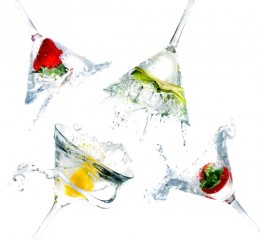


There are almost 5,000 different vodka labels. Mainly made in Russia (the leading country for vodka production and consumption) and Poland (the country which claims that it, rather than Russia, first created vodka). Vodka is also produced in the United States, Canada, Sweden, France (with Nuage vodka and Grey Goose), New Zealand (the famous '42 Below') and even Tahiti. So there's lots of variety. Traditionally, the choice was between wheat and rye: cereals produce the finest and noblest vodkas. But you can find other materials such as beetroot, potato or even fruits used for the wort. If the latter are used, the label must state that clearly. As for the alcohol level, while vodka can contain anywhere between 37.5° - 97°, everyone agrees the ideal level is between 38 – 42%. At that level, vodka's fragile, short-lived fragrances appear to be at their best. The balance being composed of water, its quality is evidently important.
As with whisky, some labels place a lot of emphasis on the quality of the water they use. Using chlorinated tapwater (even if demineralised) will, of course, not taste the same as if pure water had been used. If the label mentions 'spring water', quality will be better guaranteed. And what of labels which mention triple distillation (the Polish Wyborowa vodka or Smirnoff) or even six-fold (the French Nuage). During the first fermentation, the alcohol content can touch 78°. If you add two volumes of water, you get vodka around 40°, which is the level found in supermarkets. Theoretically, therefore, there is no need for a 2nd distillation. Other than for raising the alcohol level, adding to the number of distillations will allow the elimination of some of the bitterness left by the wort in the alcohol. So increasing the distillations makes the alcohol purer, sweeter and more refined.
The choice of vodka would vary depending on how you propose drinking it. Always choose a rye or wheat-based vodka, which has had at least 3 distillations and 10 filtrations.
The alcohol level should ideally be below 43°.If you plan having it with caviar or smoked salmon, you should choose a non-flavoured vodka (even bison-grass is not recommended).
Always serve it well-iced.You can be less demanding when drinking cocktails (vodkas with higher alcohol levels) or long drinks (flavoured vodkas).